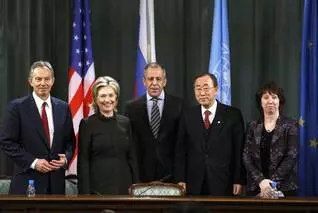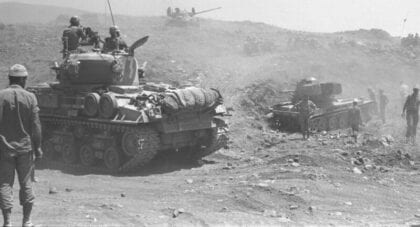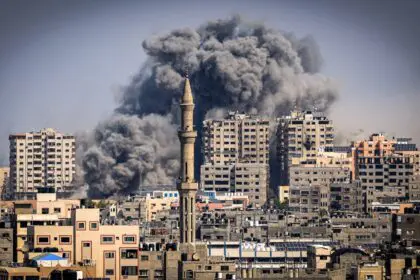The history of the Second Intifada began with Ariel Sharon's provocative visit to the Haram al-Sharif, which triggered the outbreak of the Second Intifada. This article explores the events surrounding this visit, the Palestinian reaction, and Israel's response, including the siege of the PNA headquarters in Ramallah.

The Road Map

After ‘Oslo‘ collapsed and the Second Intifada erupted, the focus of American political initiatives towards Israel and the Palestinians shifted to conflict management. The Mitchell Report of 30 April 2001 advocated an end to the violence, a freeze on all settlement activity, confidence-building measures and resumption of the negotiations. The Tenet Plan of 13 June 2001 stressed security cooperation between Israel and the PNA security forces. To a large extent, the same applied to the Road Map to Peace in the Middle East, a three-phase plan, which was launched on 30 April 2003 by the Quartet (the United States, European Union, Russian Federation, and the United Nations). The plan was endorsed by the UNSC in UNSC Resolution 1515 of 19 November 2003.
In Phase I of the Road Map, the Palestinians would end all acts of violence and disarm groups involved in it. Israel would act with military restraint against the intifada and would freeze the construction in the Jewish settlements. During Phase II an international conference would be organized as well as the creation of a Palestinian state ‘with provisional borders’. In Phase III, the negotiations over final status issues (borders, Jerusalem, settlements, refugees) would start. These negotiations were to be concluded before the end of 2005.
The Palestinians accepted the Road Map, albeit reluctantly. So did Israel. However, the Israeli government formulated no less than 14 reservations (Israel’s Road Map Reservations of 25 May 2003. The plan came before the UNSC. With the support of the United States, a resolution was passed in which the Council spoke about ‘a vision of a region where two States, Israel and Palestine, live side by side within secure and recognized borders’ (UNSC Resolution 1397 of 12 March 2002. This was the first time that the United States had formally committed itself to the establishment of an independent Palestinian state.
Although soon overtaken by developments on the ground – the Intifada, continued settlement building, construction of the so-called Wall – and although the 2005 deadline was not met, the Quartet has nevertheless repeatedly reaffirmed its commitment to the Road Map.
Al-Aqsa Intifada
On 28 September 2000, accompanied by hundreds of police officers, former (notorious) general and politician Ariel Sharon paid a visit to the Haram al-Sharif – for Muslims, the third most holy site after Mecca and Medina. It was a deliberate provocation, and occurred at a time when tensions were already high, especially in light of the fact that Sharon had found common ground with radical israeli settlers who believed that the Aqsa Mosque and Dome of the Rock should make room for the Third Temple.
Earlier, they had already provoked incidents on the Haram al-Sharif in the hope of triggering such events. In September 1996, serious riots had erupted after the Israeli government opened up a tunnel to the public which ran under the complex.
The Palestinians were quick to react to Sharon’s actions, taking to the streets in various places. From day one, the Second Intifada had a strong military character. This was in contrast to the First Intifada, which was supported by local committees and in which civil disobedience and demonstrations were the focus. In the first few days, for example, the Israeli police shot dead fourteen Palestinians of Israel.
They had taken to the streets in order to proclaim their solidarity with the Palestinians in Palestine. Armed groups of Palestinians – tied to Hamas and the Islamic Jihad, but also belonging to al-Aqsa Martyrs Brigade, which was linked to Fatah – joined the fray in a confrontation with the Israeli occupying forces and the Israeli settlers.
Israel's reaction
Thus Israeli politicians managed to convey to the West the impression that it was Arafat who was the obstruction to a political agreement between Israel and the Palestinians – and not, for example, the continuance of the occupation or the on-going settlement in Palestine. At the end of March 2002, the Israeli army besieged the PNA headquarters in Ramallah (the Mukataa or al-Muqata’a), and the building was heavily damaged. Afterwards, the Israeli army continuously laid siege to the complex, in effect placing Arafat under house arrest.
History of the Palestinian-Israeli Conflict
This article is part of our coverage of the history of the Palestinian-Israeli Conflict.
Fanack’s historical record meticulously chronicles the Palestinian-Israeli Conflict in a chronological sequence, encompassing its origins, crises, wars, peace negotiations, and beyond. It is our most exhaustive historical archive.



